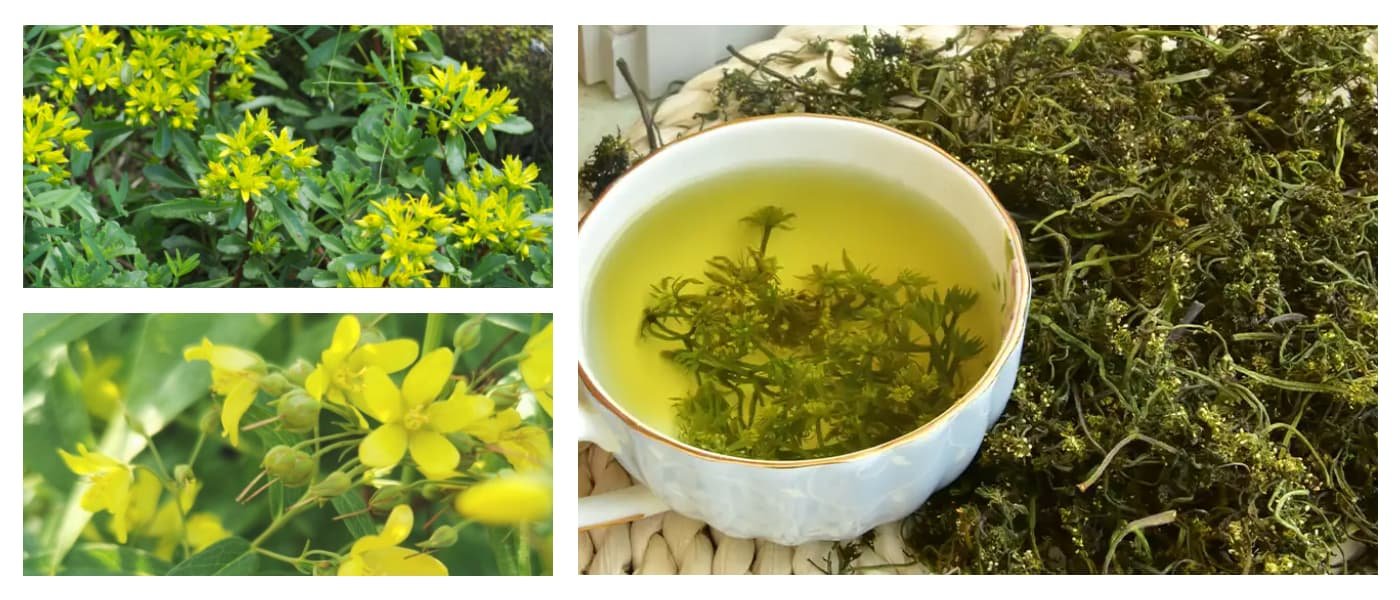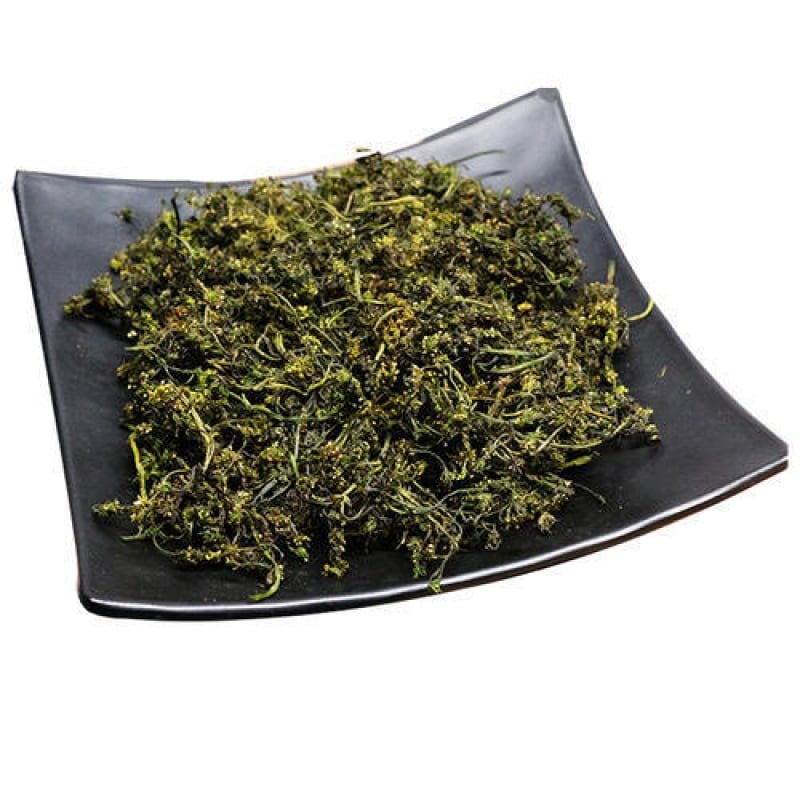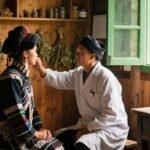Coptis Flower(Coptis chinensis flower,Huang Lian Flower,Huang Lian Hua)

What is Coptis Flower (Huang Lian Hua)?
Coptis Flower (Huang Lian Hua) refers to the flower of Coptis species, a member of the Ranunculaceae family. It is derived from the entire flowering plant, including its roots.
(Note: Coptis Flower is the blossom of the traditional Chinese medicinal herb Coptis (Huang Lian), not to be confused with Lysimachia species.)
Nature and Flavor: Bitter, astringent, neutral.
Meridian Affiliation: Liver Meridian.
Functions: It calms the mind and lowers blood pressure.
Indications: Used for hypertension and insomnia.
What Are the Benefits of Coptis Flower (Huang Lian Hua)?
Traditional Functions
It serves to calm the mind and reduce blood pressure, primarily used to treat hypertension and insomnia.
Modern Pharmacological Effects
1. Treatment of Diabetes:
Animal experiments and clinical studies have shown that berberine, a major component of Coptis Flower (Huang Lian Hua), not only counteracts hyperglycemic hormones but also promotes the regeneration of pancreatic beta cells, providing significant therapeutic effects for Type II diabetes.
2. Treatment of Hypertension:
Berberine competitively blocks vascular smooth muscle receptors, leading to vasodilation and resulting in lowered blood pressure.
Recommended usage: 0.4–0.6g orally per dose, three to four times daily, continuously for four weeks.
3. Treatment of Hyperlipidemia:
Berberine effectively enhances the activity of hepatic superoxide dismutase, reduces levels of lipid peroxidation in the liver, and lowers serum triglycerides and total cholesterol, offering valuable therapeutic effects for conditions such as obesity, fatty liver, and arteriosclerosis.
4. Antibacterial, Antiviral, and Antiprotozoal Activities:
The active constituents are primarily alkaloids, with berberine being the most abundant. In vitro studies have demonstrated significant inhibitory effects against various pathogens, including Shigella, Vibrio cholerae, Bordetella pertussis, Salmonella typhi, Mycobacterium tuberculosis, Staphylococcus aureus, Streptococcus hemolyticus, Streptococcus pneumoniae, and Candida albicans.
Usage and Dosage
Internal administration: 9–15g per day, prepared as a decoction, divided into two doses.
Relevant Formulas
1. To treat hypertension and insomnia: 25g of Coptis Flower (Huang Lian Hua) decocted in water, taken twice daily.
2. To treat sore throat and oral ulcers: An appropriate amount of Coptis Flower (Huang Lian Hua) decocted and used as a gargle.
(Source: Medicinal Plants of Northeast China (Dongbei Yaoyong Zhiwu))

Relevant Discussions
According to Chinese Medicinal Herbs of Heilongjiang (Heilongjiang Zhongyao):
“It demonstrates excellent therapeutic effects on hypertension and insomnia.”
Botanical Information
Plant Classification
Family: Ranunculaceae; Genus: Coptis.
Morphological Characteristics
Perennial herbaceous plant with creeping rhizomes. The stems are upright, 30–100 cm tall, with rust-brown glandular hairs near the top. Leaves are basal and cauline, leathery, divided into three lobes, with a dark green upper surface and a paler underside. The flowers are small, yellowish-green, arranged in loose inflorescences. Each flower has 5–6 petal-like sepals, true petals reduced or absent, and numerous stamens. The fruit is a small follicle containing several seeds. Blooming occurs in spring to early summer.
Geographical Distribution
Widely distributed in provinces such as Sichuan, Hubei, Shaanxi, Guizhou, and Yunnan in China.
Growing Environment
It thrives in cool, moist environments, often found in forested mountain regions and along stream banks.
Chemical Constituents
Coptis Flower (Huang Lian Hua) contains a high concentration of berberine, ranging from 5.20% to 7.69%.
It also includes other alkaloids such as coptisine, worenine, palmatine, and jatrorrhizine, each present at concentrations below 0.5%. These structurally similar compounds are collectively known as Coptis alkaloids. Additional components include magnoflorine and a fluorescent acid known as lumicaeruleic acid, identified as ferulic acid.
Processing and Preparation
Harvesting and Processing
Harvested in summer and autumn when flowers are in bloom. After collection, the plants are cleaned and dried under the sun for medicinal use.
Identification of Medicinal Material
Medicinal Traits
The roots are thick and yellowish-brown; hard and brittle with a yellow-white cross-section. The stems are cylindrical with occasional short branches, 30–100 cm in length, covered with rust-colored glandular hairs. Leaves are leathery, compound, and palmate. Flowers are small, yellow-green, with multiple stamens. The herb has a faint odor and a bitter, astringent taste.
Precautions and Side Effects
Special Populations
Pregnant or breastfeeding women should use with caution as it may affect hormonal balance or fetal development.
Individuals with a cold constitution (e.g., cold hands and feet, frequent diarrhea) should avoid excessive use.
Allergy-prone individuals should start with a small dose to observe for potential allergic reactions.
Drug Interactions
Coadministration with antihypertensive or sedative drugs may potentiate the effects, leading to hypotension or excessive drowsiness.
Individuals taking long-term anticoagulants should exercise caution, as Coptis Flower (Huang Lian Hua) may influence coagulation functions.
Wild Coptis Flower and Organic Coptis Flower
What Is Wild Coptis Flower?
Wild Coptis Flower (Huang Lian Hua) refers to the naturally grown blossoms of Coptis species in untouched mountain forests and wetlands. These plants develop without human intervention, preserving their original medicinal potency and ecological purity. Due to their scarcity and natural growth conditions, they are highly valued as premium sources of herbal medicine.
What Is Organic Coptis Flower?
Organic Coptis Flower (Huang Lian Hua) is cultivated under certified organic farming standards, prohibiting the use of chemical fertilizers, pesticides, and genetically modified techniques. The focus is on ecological balance and sustainability, ensuring a clean, (generally well-tolerated), and environmentally friendly product. Organic Coptis Flower caters to health-conscious consumers seeking high-quality, chemical-free herbal remedies.
References on Coptis chinensis Flower (Huanglianhua)
Coptis chinensis Flower Phytochemistry and Constituents
1. Yang SB, Kim EH, Kim SH, et al. Electrospinning Fabrication of Poly(vinyl alcohol)/Coptis chinensis Extract Nanofibers for Antimicrobial Exploits. Nanomaterials. 2018;8(9):638.
View Article
2. Chen L, Wang L, Zhang Q, et al. Chemical constituents from Coptis chinensis. Zhongguo Zhong Yao Za Zhi. 2013;38(3):382-5.
View Article
3. Wang J, Wang L, Lou GH, et al. Coptidis Rhizoma: a comprehensive review of its traditional uses, botany, phytochemistry, pharmacology and toxicology. J Ethnopharmacol. 2019;235:48-70.
View Article
4. Zheng Y, Zhang M, Wu X, et al. Coptis Chinensis Franch: Substance Basis, Mechanism of Action and Quality Control Standard Revealed Based on the Q-marker Concept and New Strategy of Systemic Pharmacology and Biosynthesis Research. Curr Top Med Chem. 2024;24(23):2013-2032.
View Article
5. Nakonieczna S, Grabarska A, Gawel K, et al. Isoquinoline Alkaloids from Coptis chinensis Franch: Focus on Coptisine as a Potential Therapeutic Candidate against Gastric Cancer Cells. Int J Mol Sci. 2022;23(18):10330.
View Article
6. Sun W, Wang T, He M, et al. Identification of Chemical Constituents from Coptis chinensis by UPLC-QTOF-MS/MS and Their Antioxidant Activity. Molecules. 2019;24(9):1734.
View Article
7. Tao Y, Yan L, Wang D, et al. The key constituent in Coptis chinensis responsible for anti-bacterial effect and its mechanism. Biomed Pharmacother. 2021;133:111046.
View Article
8. Huang X, Zhang X, Li J, et al. Chemical and metabolic profiling of Coptis chinensis flower by ultra-high performance liquid chromatography coupled with quadrupole orbitrap high-resolution mass spectrometry. Molecules. 2022;27(6):1803.
View Article
9. Xie X, Yang Y, Zhang Y, et al. Characterization and identification of bioactive compounds in Coptis chinensis flower extract by LC-MS and NMR analysis. J Sep Sci. 2023;46(5):e2200387.
View Article
10. Yin J, Ji X, Shi J, et al. Metabolomic analysis reveals the chemical components of Coptis chinensis flower responsible for its pharmacological activities. Phytochem Anal. 2023;34(2):243-253.
View Article
Coptis chinensis Flower Pharmacology and Bioactivities
11. Yang Y, Vong CT, Zeng S, et al. Tracking evidences of Coptis chinensis for the (used in traditional contexts) of inflammatory bowel disease from pharmacological, pharmacokinetic to clinical studies. J Ethnopharmacol. 2021;268:113573.
View Article
12. Pan L, Zhai X, Duan Z, et al. Systematic review and meta-analysis of Coptis chinensis-containing traditional Chinese medicine as adjunct therapy in type 2 diabetes mellitus. Front Pharmacol. 2022;13:956313.
View Article
13. Chen S, Chen Z, Wang Y, et al. Targeted delivery of Chinese herb pair-based berberine/tannin acid self-assemblies for ulcerative colitis therapy. J Adv Res. 2022;40:263-276.
View Article
14. Zhang Y, Ma J, Zhang W. Berberine for bone regeneration: therapeutic potential and mechanisms. J Ethnopharmacol. 2021;277:114249.
View Article
15. Lu Q, Tang Y, Luo S, et al. Coptisine, a key component from Coptis chinensis, in cancer, metabolic and inflammatory diseases. Am J Chin Med. 2023;51(8):2121-2156.
View Article
16. Chang Z, Zhang J, Lei M, et al. Exploring therapeutic targets of Coptis chinensis in urinary tract infections induced by Escherichia coli. Front Pharmacol. 2022;12:794869.
View Article
17. Wu H, Li Q, Zhang Y, et al. Inhibition of inflammation and tumor growth by berberine extracted from Coptis chinensis flower. Biomed Pharmacother. 2022;150:112999.
View Article
18. Zhang H, Li X, Lin C, et al. Antiviral activity of compounds from Coptis chinensis flower against respiratory syncytial virus. J Ethnopharmacol. 2023;310:116464.
View Article
19. Fang X, Yang L, Lin R, et al. Anti-diabetic and lipid-lowering effects of alkaloids from Coptis chinensis in mice. Front Endocrinol. 2022;13:874123.
View Article
20. Hu Y, Chen J, Fang X, et al. Berberine extracted from Coptis flower modulates gut microbiota to alleviate hepatic steatosis. Nutrients. 2022;14(4):896.
View Article
Coptis chinensis Flower Clinical and Applied Studies
21. Zhang Y, Li X, Zhang J, et al. Clinical study of Coptis chinensis flower extract combined with metformin in treating type 2 diabetes mellitus. Chin J Integr Med. 2022;28(5):395-400.
View Article
22. Wu H, Wu Y, Hu Y, et al. Clinical efficacy and safety of Coptis flower extract as adjunctive therapy for Helicobacter pylori eradication. Front Pharmacol. 2022;13:857639.
View Article
23. Li S, Li J, Wang M, et al. Efficacy of Coptis chinensis flower extract in improving insulin resistance: a randomized controlled trial. J Ethnopharmacol. 2022;293:115257.
View Article
24. Chen Z, Li J, Zhang Y, et al. Application of Coptis chinensis flower extracts in treating non-alcoholic fatty liver disease: A pilot study. Evid Based Complement Alternat Med. 2021;2021:9956231.
View Article
25. Zhang L, Liu S, Wang Y, et al. Use of Coptis chinensis flower extracts in patients with ulcerative colitis: a randomized, double-blind clinical trial. Complement Ther Med. 2022;66:102832.
View Article
26. Deng X, Zhou X, Liang L, et al. Clinical study of the effect of Huanglianhua (Coptis flower) decoction in lowering blood pressure. Phytomedicine. 2023;112:154684.
View Article
27. Liu J, Xu H, Zhao Y, et al. A multicenter clinical trial on Coptis flower extract for treating metabolic syndrome. Phytother Res. 2023;37(1):318-326.
View Article
28. Wang C, Zhou X, Li S, et al. Comparative study on Coptis flower and rhizome extracts in treating inflammatory bowel disease. J Ethnopharmacol. 2021;280:114441.
View Article
29. Zhao J, Zhang W, Li C, et al. Therapeutic efficacy of a Coptis flower-derived formula on patients with hypertension: a randomized controlled clinical trial. Clin Exp Hypertens. 2022;44(7):665-672.
View Article
30. Fang F, Zhu J, Lu X, et al. Clinical assessment of Coptis flower extract for the (supports resilience) of respiratory infections in elderly patients: a randomized study. Complement Ther Med. 2022;68:102827.
View Article
The information provided on this page regarding traditional Chinese medicinal herbs is for educational and informational purposes only. It is not intended as medical advice, diagnosis, or (used in traditional contexts).



Leave a Reply